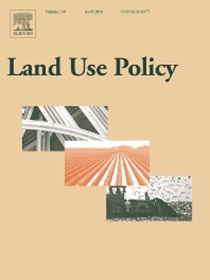埃塞俄比亚阿姆哈拉地区农村青年公共土地分配的政治-经济
IF 5.9
1区 社会学
Q1 ENVIRONMENTAL STUDIES
引用次数: 0
摘要
公共土地是埃塞俄比亚农业社区生计的重要资源。然而,公共土地被任意分配给合作社的农村青年,以解决阿姆哈拉地区紧迫的失业问题。该计划的潜在动机和对农业社区和项目受益人生计的影响仍未得到充分研究。本文以可持续生计方法为理论框架,采用混合研究方法,探讨阿姆哈拉地区公共土地分配作为一种谋生手段对失业无地青年的激励和影响。向384名已分配公共土地的使用者和150名从创造就业机会行动中受益的有组织青年发出了调查问卷。使用按主题统计对数据进行分析和解释。分配公共土地的明确目的是为农村青年创造就业机会,但这是执政党战略性地利用它在政治上控制青年、招募党员和平息进一步的问题。它是通过政治决策实施的,没有法律框架、补偿和先前用户的同意。这损害了以前的使用者的生计,影响了他们的养牛,造成饲料短缺和蜂蜜生产超过十年。但该倡议相对帮助有组织的年轻人给他们的生计带来了积极的变化,使他们能够在成为该倡议的受益者后获得资本资产和牲畜所有权。因此,在向农村青年分配公共土地时,应尊重前人对新一代的土地使用权。本文章由计算机程序翻译,如有差异,请以英文原文为准。
The political-economy of communal land distribution for rural youths in Amhara region, Ethiopia
Communal land is a vital resource for the livelihoods of agrarian communities in Ethiopia. However, communal lands were arbitrarily allocated for rural youths in cooperatives to address the pressing issue of unemployment in the Amhara region. The underlying motivations and impacts of the initiative on the livelihoods of agrarian communities and beneficiaries of the program remain understudied. Employing sustainable livelihood approach as a theoretical framework and mixed research method, this article aimed to examine the incentives and repercussions of communal land distribution for unemployed landless youths as a means of livelihood in Amhara region. A questionnaire was dispatched to 384 prior users of the distributed communal land and 150 organized youths who benefited from the job creation initiative. The data were analysed and interpreted using statistics-by-themes. The distribution of communal land was explicitly aimed at generating jobs for rural youths, but it was strategically employed by the ruling party to control youths politically, recruit party members and quell further questions. It was implemented through political decisions without legal frameworks, compensation and consent of prior users. This jeopardized the livelihoods of former users, impacting their cattle possession caused by fodder shortages and honey production over a decade. But the initiative relatively aided organized youths to bring positive changes on their livelihoods and enabling them to acquire capital assets and cattle ownership after becoming beneficiaries of the initiative. Hence, the distribution of communal lands to rural youths should respect the land use rights of prior user’s vis-a-vis emerging generations.
求助全文
通过发布文献求助,成功后即可免费获取论文全文。
去求助
来源期刊

Land Use Policy
ENVIRONMENTAL STUDIES-
CiteScore
13.70
自引率
8.50%
发文量
553
期刊介绍:
Land Use Policy is an international and interdisciplinary journal concerned with the social, economic, political, legal, physical and planning aspects of urban and rural land use.
Land Use Policy examines issues in geography, agriculture, forestry, irrigation, environmental conservation, housing, urban development and transport in both developed and developing countries through major refereed articles and shorter viewpoint pieces.
 求助内容:
求助内容: 应助结果提醒方式:
应助结果提醒方式:


